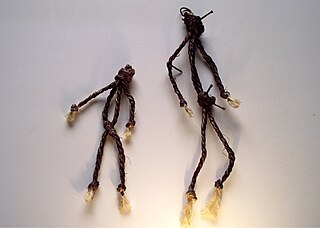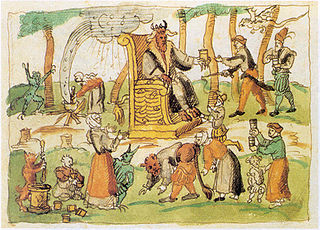 W
WAgrimonia eupatoria is a species of agrimony that is often referred to as common agrimony, church steeples or sticklewort.
 W
WA besom is a broom, a household implement used for sweeping. The term is now mostly reserved for a traditional broom constructed from a bundle of twigs tied to a stout pole. The twigs used could be broom, heather or similar. The song "Buy Broom Buzzems" from Northern England refers to both types of twig. From the phrase broom besom the more common broom comes. In Scotland, besoms are still occasionally to be found at the edge of forests where they are stacked for use in early response to an outbreak of fire.
 W
WThe title canon Episcopi is conventionally given to a certain passage found in medieval canon law. The text possibly originates in an early 10th-century penitential, recorded by Regino of Prüm; it was included in Gratian's authoritative Corpus juris canonici of c. 1140 and as such became part of canon law during the High Middle Ages.
 W
WA cauldron is a large pot (kettle) for cooking or boiling over an open fire, with a lid and frequently with an arc-shaped hanger. In other words, a large kettle.
 W
WConcealed shoes hidden in the fabric of a building have been discovered in many European countries, as well as in other parts of the world, since at least the early modern period. Independent researcher Brian Hoggard has observed that the locations in which these shoes are typically found – in chimneys, under floors, above ceilings, around doors and windows, in the roof – suggest that some may have been concealed as magical charms to protect the occupants of the building against evil influences such as demons, ghosts and witches. Others may have been intended to bestow fertility on a female member of the household, or been an offering to a household deity.
 W
WBelief in and practice of witchcraft in Europe can be traced to classical antiquity and has continuous history during the Middle Ages, culminating in the Early Modern witch hunts and giving rise to the fairy tale and popular culture "witch" stock character of modern times, as well as to the concept of the "modern witch" in Wicca and related movements of contemporary witchcraft.
 W
WIn European folklore of the medieval and early modern periods, familiars were believed to be supernatural entities that would assist witches and cunning folk in their practice of magic. According to records of the time, those alleging to have had contact with familiar spirits reported that they could manifest as numerous forms, usually as an animal, but sometimes as a human or humanoid figure, and were described as "clearly defined, three-dimensional... forms, vivid with colour and animated with movement and sound", as opposed to descriptions of ghosts with their "smoky, undefined form[s]".
 W
WFlying ointment is a hallucinogenic ointment said to have been used by witches in the practice of European witchcraft from at least as far back as the Early Modern period, when detailed recipes for such preparations were first recorded.
 W
WA grimalkin is an archaic term for a cat. The term stems from "grey" plus "malkin", an archaic term with several meanings derived from a hypocoristic form of the female name Maud. Scottish legend makes reference to the grimalkin as a faery cat that dwells in the highlands.
 W
WAn imp is a European mythological being similar to a fairy or demon, frequently described in folklore and superstition. The word may perhaps derive from the term ympe, used to denote a young grafted tree.
 W
WA kitchen witch, sometimes called a cottage witch or a "Scandinavian" kitchen witch doll, is a poppet or homemade doll resembling a stereotypical witch or crone displayed in residential kitchens as a good luck charm and to ward off bad spirits.
 W
WOsculum infame is the name of a witch's supposed ritual greeting upon meeting with the Devil. The name means The Shameful Kiss, or The Kiss of Shame since it involved kissing the devil's anus, his other mouth. According to folklore, it was this kiss that allowed the Devil to seduce women.
 W
WIn folk magic and witchcraft, a poppet is a doll made to represent a person, for casting spells on that person or to aid that person through magic. They are occasionally found lodged in chimneys. These dolls may be fashioned from such materials as a carved root, grain or corn shafts, a fruit, paper, wax, a potato, clay, branches, or cloth stuffed with herbs with the intent that any actions performed upon the effigy will be transferred to the subject based on sympathetic magic. Poppets are also used as kitchen witch figures.
 W
WSatanism and Witchcraft is a book by Jules Michelet on the history of witchcraft. Originally published in Paris as La Sorcière in 1862, the first English translation appeared in London a year later.
 W
WThe Larzac tablet is a lead curse tablet found in 1983 in the commune of L'Hospitalet-du-Larzac, Aveyron, southern France. It is now kept in the museum of Millau. It bears one of the most important inscriptions in the Gaulish language.
Summis desiderantes affectibus, sometimes abbreviated to Summis desiderantes was a papal bull regarding witchcraft issued by Pope Innocent VIII on 5 December 1484.
 W
WIn medieval lore, Tempestarii were weather making magicians who dwelt amongst the common people and possessed the power to raise or prevent storms at will. For this reason, anyone reputed as a weather-maker was the subject of respect, fear, and hatred in rural areas.
 W
WThe term Voodoo doll commonly describes an effigy into which pins are inserted. Such practices are found in various forms in the magical traditions of many cultures across the world. Although the use of the term Voodoo implies that the practice is linked to Haitian Vodou or Louisiana Voodoo, it is not prominent in either.
 W
WA warlock is a male practitioner of witchcraft.
 W
WA witch doctor was originally a type of healer who treated ailments believed to be caused by witchcraft. The term is now more commonly used to refer to healers, particularly in regions which use traditional healing rather than contemporary medicine.
 W
WA witch hat is a style of hat worn by witches in popular culture depictions, characterized by a conical crown and a wide brim.
 W
WThe witch-cult hypothesis is a discredited theory that proposes that the witch trials of the Early Modern period were an attempt to suppress a pre-Christian, pagan religion that had survived the Christianisation of Europe. According to its proponents, the witch cult revolved around the worship of a Horned God of fertility, the underworld, the hunt and the hunted, whose Christian persecutors referred to him as the Devil, and whose followers participated in nocturnal rites at the witches' Sabbath.
 W
WAccording to witch-hunters during the height of the witch trials, the witch's mark or devil's mark indicated that an individual was a witch. The beliefs about the mark differ depending on the trial location and the accusation made against the witch. Evidence of the witch's mark is found earliest in the 16th century, and reached its peak in 1645, then essentially disappeared by 1700. The Witch or Devil's mark was believed to be the permanent marking of the Devil on his initiates to seal their obedience and service to him. He created the mark by raking his claw across their flesh, or by making a blue or red brand using a hot iron. Sometimes, the mark was believed to have been left by the Devil licking the individual leaving a death skull pattern in the skin. The Devil was thought to mark the individual at the end of nocturnal initiation rites. The witch's teat was a raised bump somewhere on a witch's body. It is often depicted as having a wart-like appearance.
 W
WA Witches' Sabbath is a purported gathering of those believed to practice witchcraft and other rituals. The phrase became popular in the 20th century.
 W
WZamkova Hora hill in Kyiv, Ukraine is a historical landmark in the center of the city. It is part of the city's geographic relief complex known as Kyiv Mountains. The place is called "Zamkova" because Vytautas the Great had his castle here. Other names: Khorevytsya, Kyselivka, Frolovska, Lysa Hora. Some important events of Ukrainian history took place on the hill.
 W
WA zduhać and vetrovnjak in Serbian tradition, and a dragon man in Bulgarian, Macedonian and southern Serbian traditions, were men believed to have an inborn supernatural ability to protect their estate, village, or region against destructive weather conditions, such as storms, hail, or torrential rains. It was believed that the souls of these men could leave their bodies in sleep, to intercept and fight with demonic beings imagined as bringers of bad weather. Having defeated the demons and taken away the stormy clouds they brought, the protectors would return into their bodies and wake up tired.